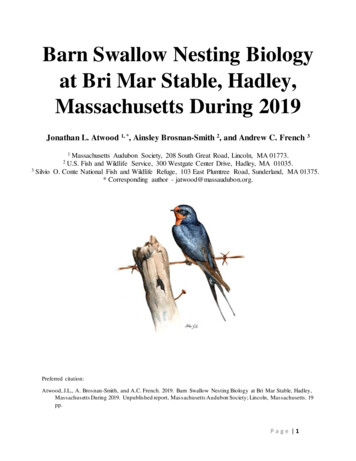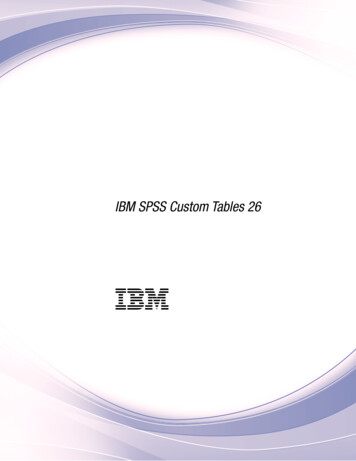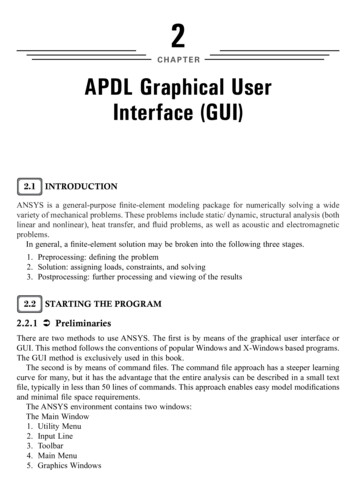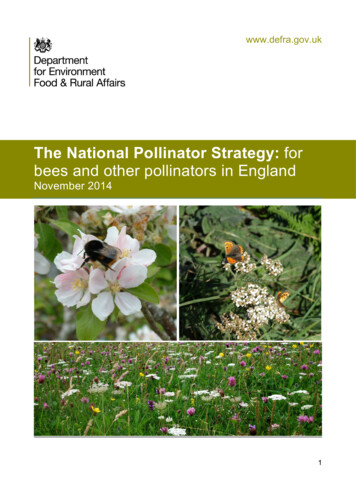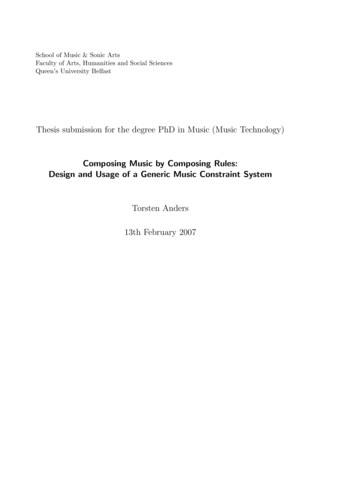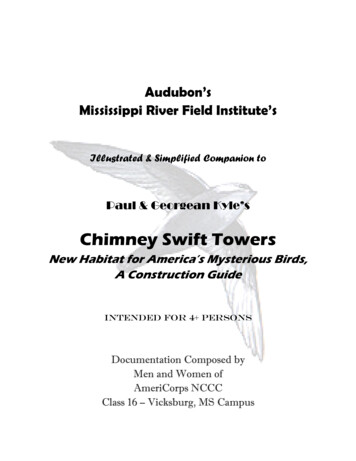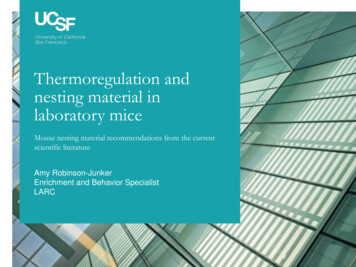
Transcription
Thermoregulation andnesting material inlaboratory miceMouse nesting material recommendations from the currentscientific literatureAmy Robinson-JunkerEnrichment and Behavior SpecialistLARC
The Guide and thermoregulation2 “In general, dry-bulb temperatures in animal rooms should beset below the animals’ LCT to avoid heat stress. This, in turn,means that animals should be provided with adequateresources for thermoregulation (nesting material, shelter) toavoid cold stress.” – Ch 3, p 43 “A number of species, most notably rodents, exhibit a clearpreference for specific materials (Blom et al. 1996; Manser etal. 1997, 1998; Ras et al. 2002), and mice provided withappropriate nesting material build better nests (Hess et al.2008).” – Ch 3, p 68Thermoregulation and nesting material in laboratory mice
Cold stressGeneral terms What does “stress”actually mean?- Comfort – homeostasismaintained with noadditional resource use- Stress – homeostasismaintenance requiresresource allocation- Distress – homeostasiscannot be maintainedwithout compromisingother biological functionsImgur/emirbytesFeral Cats IrelandMoberg 19993Thermoregulation and nesting material in laboratory mice
How can we assess mouse cold stress?Physiological measures4 Male C57BL/6 mice show anti-inflammatory, pro-inflammatory cytokineresponse to influenza when housed at 30 C than at 26 C or 22 C(Jhaveri et al 2007) BALB/c mice use less brown fat thermogenesis when supplied with nestingmaterial (Gaskill et al 2013a) BALB/c and C57BL/6 mice in breeding pairs housed with nesting materialweaned an average of 11 more pups over 6 months; those pups were also,on average, 1.25g heavier (Gaskill et al 2013b) Mice (incl SCID, NUDE, BALB/c, and C57BL/6) housed at thermoneutralityshowed decreased tumor growth and metastasis rates (4 diff types oftumor) when housed at thermoneutrality (Kokolus et al 2013) Male C57BL/6 mice housed at standard temps use 3 times their restingmetabolic requirements at thermoneutrality. This is equivalent to a humannaked at 5 C or walking 100 km/day (Fischer et al 2017)Thermoregulation and nesting material in laboratory mice
How can we assess mouse cold stress?Behavioral measures5 C57BL/6 mice of both sexes given a choice between20/25/30 C spent the majority of their time in 30 C. Moreinactive and maintenance time was spent there, too (Gaskillet al 2009) C57BL/6 mice provided with 8g of nesting material doubledthe amount of time they spent in 20 C, but still spent morethan 50% of their time in 30 C (Gaskill et al 2011) BALB/c female mice housed in a thermocline spent themajority of their time during the day in the 35-39 C end andengaged in very little nest building there (Gordon et al 2014)Thermoregulation and nesting material in laboratory mice
Why are mice cold? Large surface area:volume ratio – loses heatquickly- Heavier mice, like CD-1s,are slightly less affected Ventilated caging?- Studies have shown micefind high IVC ratesaversive (Baumans et al2002) and IVC increasesbrown fat thermogenesis(David et al 2013)6Thermoregulation and nesting material in laboratory mice
How do they cope?Physiological responseIncreased brownfat thermogenesisIncreased metabolic rateWild mouseLives in walk-in freezer(-23 C)Behavioral responseThermotaxisNest buildingHuddling7Thermoregulation and nesting material in laboratory mice
How can they cope?Modifiers of coping mechanisms in the laboratory Opportunity- No chance for thigmotaxis- No huddling if housedsingly Ability- Some mouse strains are“better” nesters than others- Physical condition8Thermoregulation and nesting material in laboratory mice Materials- Some nesting materialsmake higher scoring neststhan others- Material durability, esp with3 week cage changes- Bedding that can beintegrated into the nest canmodify nest score- Amount of materialprovided affects nest score
Mouse nestsWhat’s a nest score, anyway? Nest scoring is based onshape of nest Higher scoring nests - higher in-nest temperature(Gaskill et al 2013a) Decreases in nest scorescan indicate illness and/orpain (Rock et al 2014, Hageret al 2015, Gaskill andPritchett-Corning 2016)9Thermoregulation and nesting material in laboratory miceGaskill et al 2013a
Nest scoringHess et al 200810Thermoregulation and nesting material in laboratory mice
Mouse nestsWhat enables high nest scores? Type of material- More naturalistic (shredded paper) - higher nest scores than lessnaturalistic (pressed cotton) (Hess et al 2008) Amount of material matters- Mice in static cages need at least 8-10g of material to build thermallyinsulating nests (Gaskill et al 2012)11Thermoregulation and nesting material in laboratory mice
UCSFCurrent approach Vast majority of mice housed sociallyMajority of mice housed in IVC cagingVast majority of mice housed on paper chip beddingAll cages receive some form of nesting material unless thereis an IACUC approved protocol“Standard” is 1 Nestlet ( 2.6g) per cage- Not uniform across facilities or rooms- Some use shredded paper, esp with nudes 12Sentinel mice receive 2-3 NestletsThermoregulation and nesting material in laboratory mice
UCSFExample cages13Thermoregulation and nesting material in laboratory mice
UCSFExample cages14Thermoregulation and nesting material in laboratory mice
UCSFRecommendations Strongly recommended- Increase nesting materialto 8g per cage- Automatically supplyadditional nesting material(up to 10g) to singlyhoused mice, includingsentinels- Prefer shredded paper tocompressed cotton- Transfer nesting materialat cage change15Thermoregulation and nesting material in laboratory mice
UCSFLarger scale potential improvements Consider using beddingwith greater insulatingproperties/that can beincorporated into the nest- Also provides furtheropportunities to engage innatural behaviors(foraging, sorting,processing)Robinson-Junker et al 201616Thermoregulation and nesting material in laboratory mice
References1.Baumans, V., F. Schlingmann, M. Vonck, and H. A. van Lith. 2002. “Individually Ventilated Cages: Beneficial for Mice and Men?” Contemp Top Lab Anim Sci 41 (1): 13–19.2.David, John M, Scott Knowles, Donald M Lamkin, and David B Stout. 2013. “Individually Ventilated Cages Impose Cold Stress on Laboratory Mice: A Source of Systemic ExperimentalVariability.” Journal of the American Association for Laboratory Animal Science : JAALAS 52 (6): 738–44.3.Fischer, Alexander W., Barbara Cannon, and Jan Nedergaard. 2017. “Optimal Housing Temperatures for Mice to Mimic the Thermal Environment of Humans: An Experimental Study.”Molecular Metabolism 7 (October): 161–70. kill, B. N., C. J. Gordon, E. A. Pajor, J. R. Lucas, J. K. Davis, and J. P. Garner. 2012. “Heat or Insulation: Behavioral Titration of Mouse Preference for Warmth or Access to a Nest.”PLoS One 7 (3): e32799. ——. 2013. “Impact of Nesting Material on Mouse Body Temperature and Physiology.” Physiol Behav 110–111 (February): 87–95. skill, B. N., and K. R. Pritchett-Corning. 2016. “Nest Building as an Indicator of Illness in Laboratory Mice.” Applied Animal Behaviour Science 180 (July): 4.008.7.Gaskill, B. N., K. R. Pritchett-Corning, C. J. Gordon, E. A. Pajor, J. R. Lucas, J. K. Davis, and J. P. Garner. 2013. “Energy Reallocation to Breeding Performance through Improved NestBuilding in Laboratory Mice.” PLoS One 8 (9): e74153. kill, Brianna N., Stephanie A. Rohr, Edmond A. Pajor, Jeffrey R. Lucas, and Joseph P. Garner. 2009. “Some like It Hot: Mouse Temperature Preferences in Laboratory Housing.”Applied Animal Behaviour Science 116 (2–4): 279–85. ��——. 2011. “Working with What You’ve Got: Changes in Thermal Preference and Behavior in Mice with or without Nesting Material.” Journal of Thermal Biology 36 (3): 2.004.10.Gordon, Christopher J., Cenk Aydin, Elizabeth A. Repasky, Kathleen M. Kokolus, Geoffrey Dheyongera, and Andrew F. M. Johnstone. 2014. “Behaviorally Mediated, Warm Adaptation: APhysiological Strategy When Mice Behaviorally Thermoregulate.” Journal of Thermal Biology 44 (August): 41–46. Hager, C., L. M. Keubler, S. Biernot, J. Dietrich, S. Buchheister, M. Buettner, and A. Bleich. 2015. “Time to Integrate to Nest Test Evaluation in a Mouse DSS-Colitis Model.” PLoS One 10(12): e0143824. averi, K. A., R. A. Trammell, and L. A. Toth. 2007. “Effect of Environmental Temperature on Sleep, Locomotor Activity, Core Body Temperature and Immune Responses of C57BL/6JMice.” Brain, Behavior, and Immunity 21 (7): 975–87. us, K. M., M. L. Capitano, C. T. Lee, J. W. Eng, J. D. Waight, B. L. Hylander, S. Sexton, et al. 2013. “Baseline Tumor Growth and Immune Control in Laboratory Mice Are SignificantlyInfluenced by Subthermoneutral Housing Temperature.” Proc Natl Acad Sci U S A 110 (50): 20176–81. https://doi.org/10.1073/pnas.1304291110.14.Moberg, Gary P. 1999. “When Does Stress Become Distress?” Lab Animal 28 (4): 22–26.15.National Research Council. 2011. Guide for the Care and Use of Laboratory Animals: Eighth Edition. Washington, DC: The National Academies Press. https://doi.org/10.17226/12910.16.Robinson-Junker, Amy, Amelia Morin, Kathleen Pritchett-Corning, and Brianna N. Gaskill. 2017. “Sorting It out: Bedding Particle Size and Nesting Material Processing Method Affect NestComplexity.” Laboratory Animals 51 (2): 170–80. https://doi.org/10.1177/0023677216652384.17.Rock, Meagan L., Alicia Z. Karas, Katherine B. Gartrell Rodriguez, Miranda S. Gallo, Kathleen Pritchett-Corning, Richard H. Karas, Mark Aronovitz, and Brianna N. Gaskill. 2014. “TheTime-to-Integrate-to-Nest Test as an Indicator of Wellbeing in Laboratory Mice.” Journal of the American Association for Laboratory Animal Science 53 (1): 24–28.17Thermoregulation and nesting material in laboratory mice
Male C57BL/6 mice show anti-inflammatory, pro-inflammatory cytokine response to influenza when housed at 30 C than at 26 C or 22 C (Jhaveri et al 2007) BALB/c mice use less brown fat thermogenesis when supplied with nesting material (Gaskill et al 2013a) BALB/c and C57BL/6 mice in breeding pairs housed with nesting material
